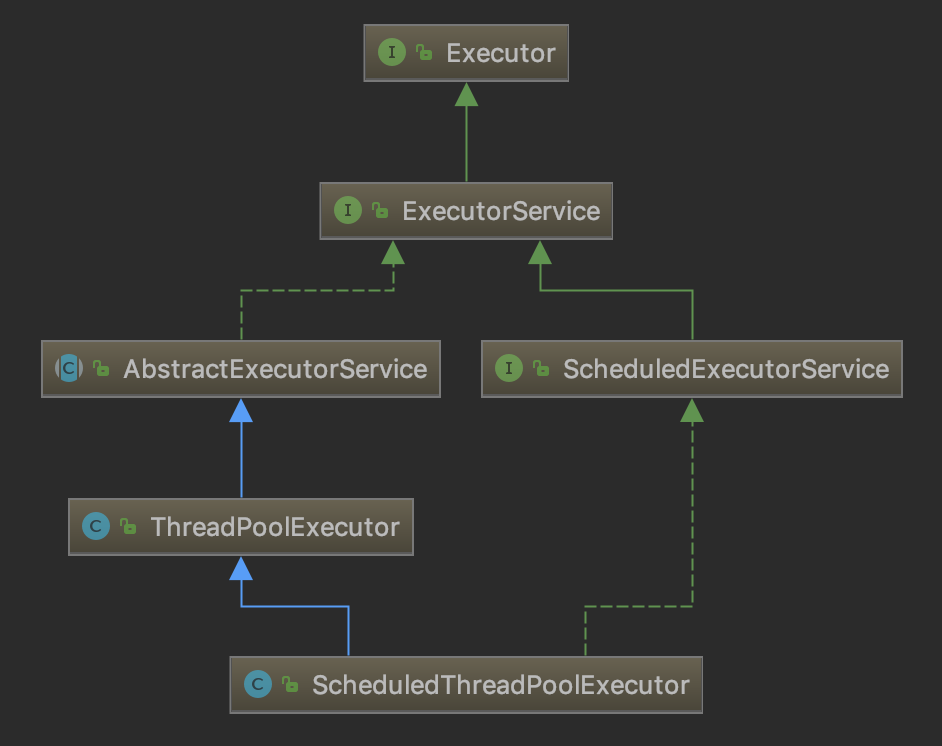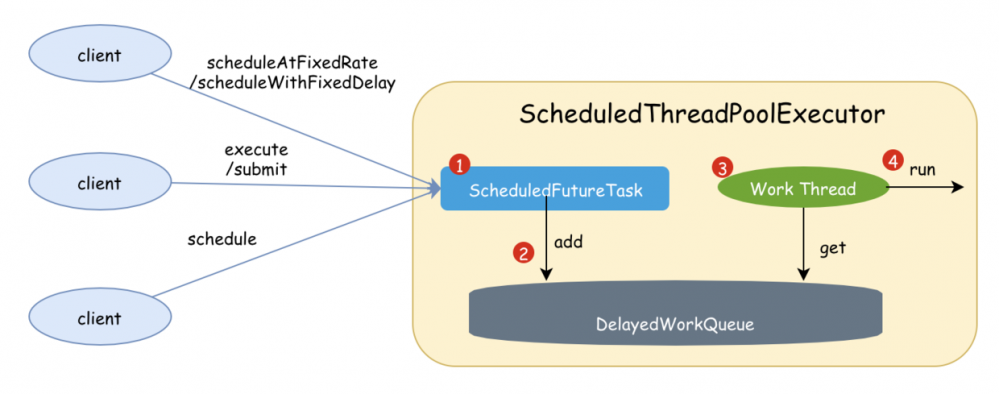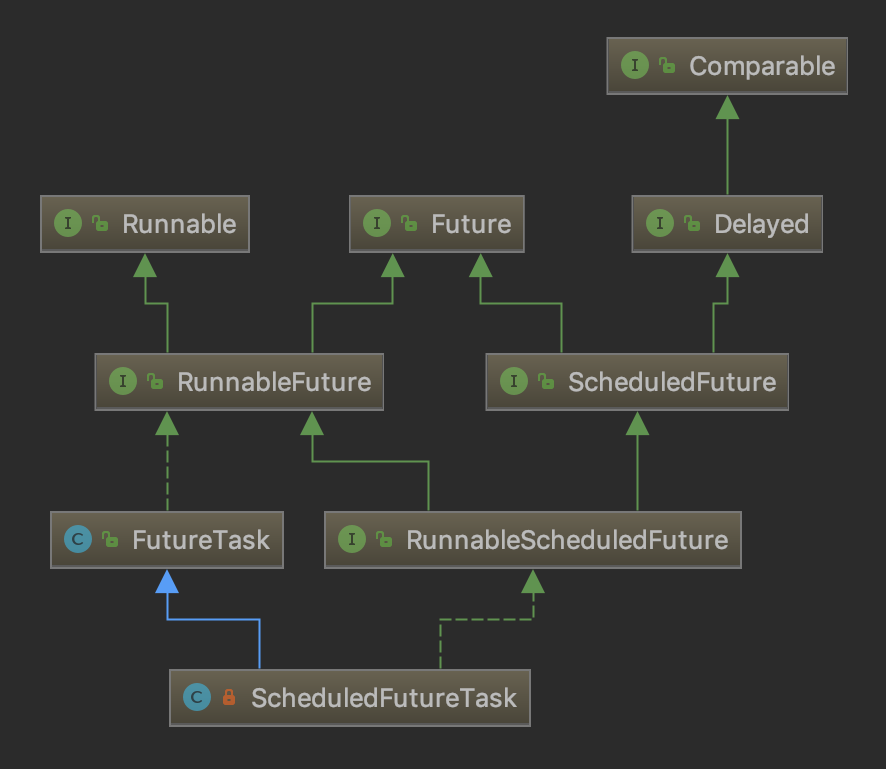Java并发-ScheduledThreadPoolExecutor
A ThreadPoolExecutor that can additionally schedule commands to run after a given delay, or to execute periodically( 周期性地 ) . This class is preferable to( 优先于…… ) Timer when multiple worker threads are needed, or when the additional flexibility( 灵活性 ) or capabilities of ThreadPoolExecutor (which this class extends) are required.
Delayed tasks execute no sooner than they are enabled, but without any real-time guarantees about when, after they are enabled, they will commence. Tasks scheduled for exactly the same execution time are enabled in first-in-first-out (FIFO) order of submission.
When a submitted task is cancelled before it is run, execution is suppressed. By default, such a cancelled task is not automatically removed from the work queue until its delay elapses. While this enables further inspection and monitoring, it may also cause unbounded retention of cancelled tasks. To avoid this, set setRemoveOnCancelPolicy to true, which causes tasks to be immediately removed from the work queue at time of cancellation .
Extension notes : This class overrides the execute and submit methods to generate internal ScheduledFuture objects to control per-task delays and scheduling. To preserve functionality, any further overrides of these methods in subclasses must invoke superclass versions, which effectively disables additional task customization. However, this class provides alternative protected extension method decorateTask (one version each for Runnable and Callable) that can be used to customize the concrete task types used to execute commands entered via execute , submit , schedule , scheduleAtFixedRate , and scheduleWithFixedDelay . By default, a ScheduledThreadPoolExecutor uses a task type extending FutureTask .
类层次结构

构造方法
public ScheduledThreadPoolExecutor(int corePoolSize) {
super(corePoolSize, Integer.MAX_VALUE, 0, NANOSECONDS,
new DelayedWorkQueue());
}
public ScheduledThreadPoolExecutor(int corePoolSize,
ThreadFactory threadFactory) {
super(corePoolSize, Integer.MAX_VALUE, 0, NANOSECONDS,
new DelayedWorkQueue(), threadFactory);
}
public ScheduledThreadPoolExecutor(int corePoolSize,
RejectedExecutionHandler handler) {
super(corePoolSize, Integer.MAX_VALUE, 0, NANOSECONDS,
new DelayedWorkQueue(), handler);
}
public ScheduledThreadPoolExecutor(int corePoolSize,
ThreadFactory threadFactory,
RejectedExecutionHandler handler) {
super(corePoolSize, Integer.MAX_VALUE, 0, NANOSECONDS,
new DelayedWorkQueue(), threadFactory, handler);
}
复制代码
执行和调度任务方法
public ScheduledFuture<?> schedule(Runnable command,
long delay,TimeUnit unit)
public <V> ScheduledFuture<V> schedule(Callable<V> callable,
long delay,TimeUnit unit)
public ScheduledFuture<?> scheduleAtFixedRate(Runnable command,
long initialDelay,long period,TimeUnit unit)
public ScheduledFuture<?> scheduleWithFixedDelay(Runnable command,
long initialDelay,long delay,TimeUnit unit)
public Future<?> submit(Runnable task)
public <T> Future<T> submit(Runnable task, T result)
public <T> Future<T> submit(Callable<T> task)
复制代码
其他方法
public void setContinueExistingPeriodicTasksAfterShutdownPolicy(boolean value) public boolean getContinueExistingPeriodicTasksAfterShutdownPolicy() public void setExecuteExistingDelayedTasksAfterShutdownPolicy(boolean value) public boolean getExecuteExistingDelayedTasksAfterShutdownPolicy() public void setRemoveOnCancelPolicy(boolean value) public boolean getRemoveOnCancelPolicy() public void shutdown() public List<Runnable> shutdownNow() public BlockingQueue<Runnable> getQueue() 复制代码
实现原理
ScheduledThreadPoolExecutor 调度和执行任务的过程可以抽象如下图所示:

- 将
Callable或Runnable对象转换ScheduledFutureTask对象; - 将转换后的
ScheduledFutureTask对象添加到延迟队列并开启线程执行任务; - 工作线程从队列获取
ScheduledFutureTask任务执行任务。
通过上述描述可以发现, ScheduledFutureTask 是 ScheduledThreadPoolExecutor 实现的关键。
源码分析
public ScheduledFuture<?> schedule(Runnable command,
long delay,
TimeUnit unit) {
// 步骤1
RunnableScheduledFuture<?> t = decorateTask(command,
new ScheduledFutureTask<Void>(command, null,
triggerTime(delay, unit)));
// 步骤2
delayedExecute(t);
return t;
}
public ScheduledFuture<?> scheduleAtFixedRate(Runnable command,
long initialDelay,
long period,
TimeUnit unit) {
ScheduledFutureTask<Void> sft =
new ScheduledFutureTask<Void>(command,
null,
triggerTime(initialDelay, unit),
unit.toNanos(period));
RunnableScheduledFuture<Void> t = decorateTask(command, sft);
sft.outerTask = t;
delayedExecute(t);
return t;
}
// 将任务添加到延迟队列
private void delayedExecute(RunnableScheduledFuture<?> task) {
if (isShutdown())
reject(task);
else {
super.getQueue().add(task);
if (isShutdown() &&
!canRunInCurrentRunState(task.isPeriodic()) &&
remove(task))
task.cancel(false);
else
ensurePrestart();
}
}
复制代码
ScheduledFutureTask
类层次结构

构造方法
ScheduledFutureTask(Runnable r, V result, long ns) {
super(r, result);
this.time = ns;
this.period = 0;
this.sequenceNumber = sequencer.getAndIncrement();
}
ScheduledFutureTask(Runnable r, V result, long ns, long period) {
super(r, result);
this.time = ns;
this.period = period;
this.sequenceNumber = sequencer.getAndIncrement();
}
ScheduledFutureTask(Callable<V> callable, long ns) {
super(callable);
this.time = ns;
this.period = 0;
this.sequenceNumber = sequencer.getAndIncrement();
}
}
复制代码
任务执行
public void run() {
boolean periodic = isPeriodic();
if (!canRunInCurrentRunState(periodic))
cancel(false);
else if (!periodic) // 非周期性任务,直接执行
ScheduledFutureTask.super.run();
else if (ScheduledFutureTask.super.runAndReset()) { // 执行任务,重置状态
// 计算下一次执行时间
setNextRunTime();
// 重新添加到延迟队列
reExecutePeriodic(outerTask);
}
}
void reExecutePeriodic(RunnableScheduledFuture<?> task) {
if (canRunInCurrentRunState(true)) {
super.getQueue().add(task);
if (!canRunInCurrentRunState(true) && remove(task))
task.cancel(false);
else
ensurePrestart();
}
}
复制代码











![[HBLOG]公众号](https://www.liuhaihua.cn/img/qrcode_gzh.jpg)

